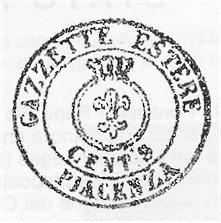 |
 |
(from "Catalogo Sassone Specializzato", ed. 2001)
Newspaper
revenue stamps - general introduction
As already
seen for other Duchies, also the Modena Duchy instituted this tax on the out
of State newspapers, mainly on the ones of political origin to create obstacles
to the diffusion of hostile and too liberal ideas.
And, as in the Modena case (as seen also for other States) it has been in demand
by collectors even if it is not a true postage stamp.
From February 1853 and up to the introduction of the stamps for that purpose,
the tax was collected by special cancellation marks, one in use in Parma and
another in Piacenza (Fig. 1); this tax was valid from August 1852 but
it was applied practically only from February 1st of the following year. The
tax was set at 9 centesimi.
 |
 |
From April 1853 a new stamp started to circulate. It substitutes gradually these
stamps (the Piacenza one stayed in use much longer than the Parma one).
Donnino Bentelli made the minting die. The subject is an octagon made by curved
lines where at top is the label "STATI PARMENSI" with below an horizontal
dividing line; in the lower part of the stamp there is a semicircular label
with "CENTESIMI" and below the indication of the value. The typographic
printing in black was executed on blue paper of very bad quality, very thin
and uniform, without watermark by the Parma Postal Administration in sheets
of 60 parts (10 rows of 6 revenue stamps). Two different printing runs were
executed of 120,000 pieces each (April 1853 and September 1855) where the location
of the single stereotypes is not the same. The paper was in a darker shade in
comparison with the first printing run.
To be noticed that it was practically never cancelled (with some very rare exception)
because it was reusable by private people anyway.
It stayed in use up to the appearance of the new revenue stamp of 6 centesimi,
November 1st 1857 that was needed as consequence of the tax reduction.
This new revenue stamps is the same of the previous one because the number "9"
was substituted with the number "6", but it was printed in pink colored
appear, always of very bad quality, in sheets of 100 pieces (10x10) by the Stefano
Rossi-Ubaldi printing house. Three different printing runs were made: the first
one in October 1857 of 6,000 pieces, at the printing house just mentioned; the
second one (110,000 pieces-November 1857) and the third one (600,000 pieces-February
1859) at the Parma local Postal Administration place by the workers of the Rossi-Ubaldi
printing house. This last printing run was never used and was fully placed in
the philatelic market. It is distinguishable because the paper is much thinner
than the two previous ones and in paler color shade. This revenue stamp was
valid up to June 14th 1859 in Piacenza and up to July 7th 1859 in all the other
places.
For both revenue stamps we find numerous stereotypes defects with numbers, labels
and frames often interrupted or ruined (the 9 centesimi defects will be found
later on in the Provisional Government).
Summarizing, the newspaper revenue stamps are the following:
|
Type
|
Color
|
Paper
|
Issue
|
Quantity
|
|
9 centesimi
|
Pale
blue
|
Medium-thin
|
April
1853
|
120.000
|
|
9 centesimi
|
Blue
|
Thin
|
September
1855
|
120.000
|
|
6 centesimi
|
Pink
|
Medium
|
October
1857
|
6.000
|
|
6 centesimi
|
Pink
|
Medium
|
November
1857
|
110.000
|
|
6
centesimi - not issued -
|
Pale
pink
|
Thin
|
February
1859
|
600.000
|